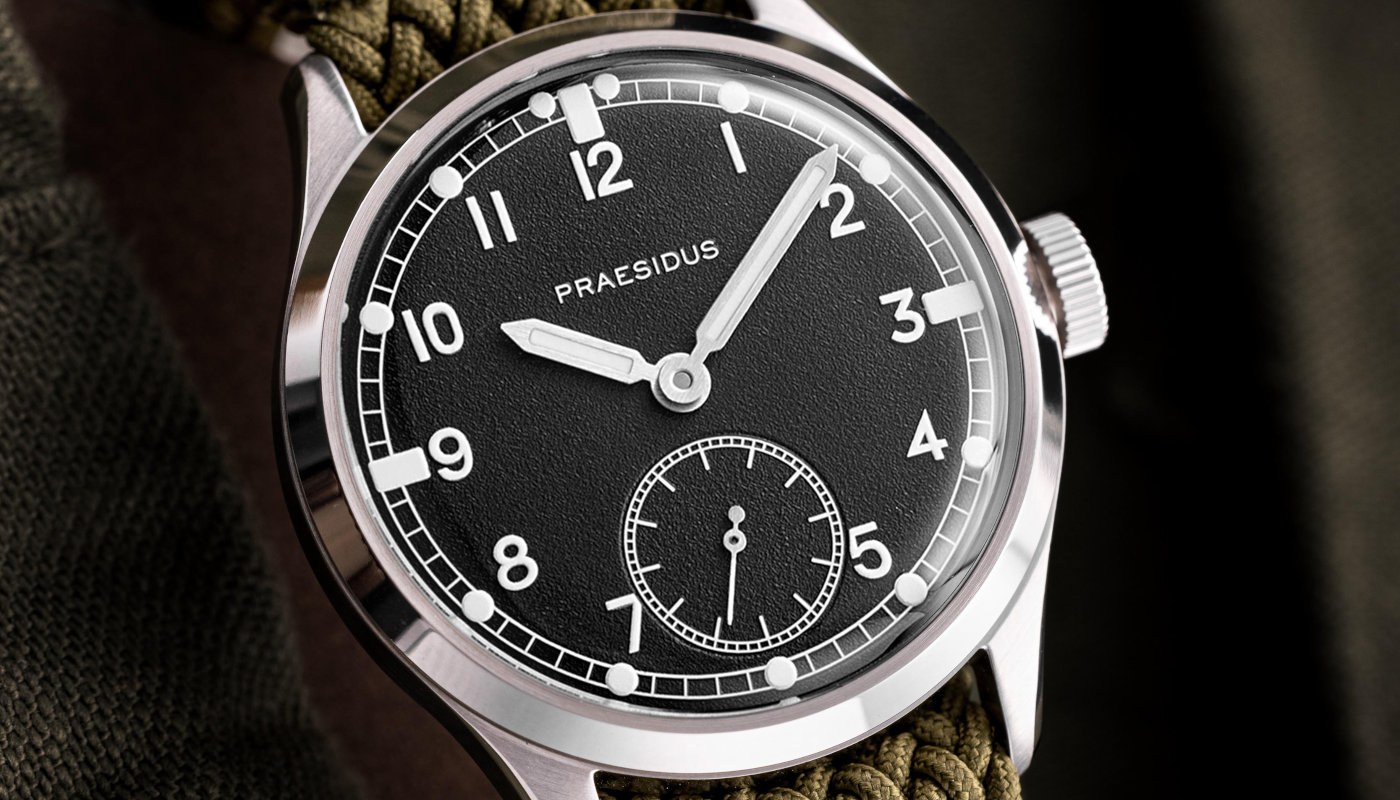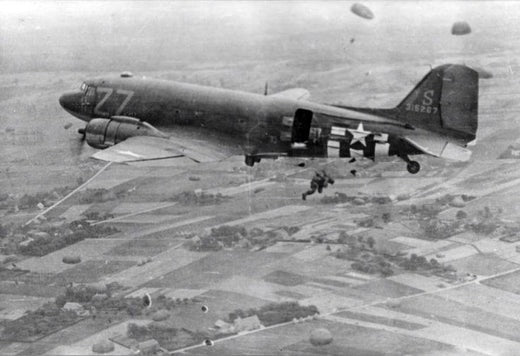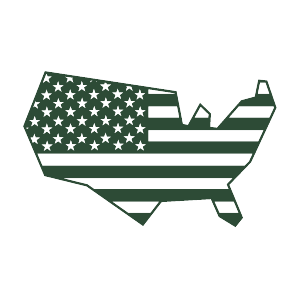Of all the US military's iconic "workhorse" equipment deployed during WW2, none was more widely and effectively deployed than the Douglas C-47 transport plane.
The C-47 Skytrain, also known as the "Gooney Bird," is probably the most iconic military transport aircraft ever developed. Born from the civilian Douglas DC-3 airliner, it rose to fame thanks to its versatility, durability, and ease of manufacturing ultimately playing a pivotal role in the Allied landings & ultimate victory. Its story is one of ingenuity, simplicity and plain old American manufacturing.

A Commercial Success Militarized
The C-47 Skytrain was developed by the Douglas Aircraft Company in the 1930s. Building on the success of the DC-3; the first commercial airliner capable of turning a profit without US Mail subsidies, it made sense for the US Army Air Corps (USAAC) to request their own version. This came on the back of the successful integration of the smaller sized DC-2 into the USAAC for supply missions.
When compared, the DC-3 & C-47 are therefore pretty much the same airframe. The main differences were focused on improving the adaptability of the plane for military missions.
The C-47 cabin was therefore significantly modified - featuring reinforced flooring, a large two-panel port-side cargo door and fittings for strapping down cargo during supply flights. The cargo door was also usable as a paradrop door. Additionally, an astrolabe "bubble" was added above the cockpit for improve navigation capabilities.
On the outside, the wingspan was 6 inches wider than the similar DC-3A, and the fuel capacity was increased from 804 to 822 gallons with interior fittings for nine 100-gallon fuselage fuel tanks for added endurance. Later versions were also equipped for glider towing.
The aircraft was flown by a pilot and co-pilot with a radio operator and could carry either 6,000 pounds of cargo, 28 fully equipped paratroopers, or 14 stretchers with medical attendants. This meant it could fulfill nearly any transport role the USAAC had with minimal modifications or constraints.

Overall, the key specifications of the C-47 include:
- Wingspan: 95 feet
- Length: 64 feet 5 inches
- Height: 16 feet 11 inches
- Maximum Speed: 230 mph
- Max Range:1,600 miles
- Crew: 3 (pilot, co-pilot, and radio operator)
- Cargo Capacity: 6,000 pounds or 28 fully equipped troops
A Design Success propelled by American Manufacturing Might
On Sept. 16 1940, the USAAF (renamed from the USAAC earlier in the year) realizing their technical & numerical inferiority with regards to transport aircraft ordered a first batch of 545 C-47s for delivery almost a year later in mid-1941. This was in a context of war in Europe but, pre-Pearl Harbor. Back then 545 planes to be delivered over the course of almost a year was not surprising. It was already an overly large order for Douglas (the manufacturer) which was forced to pull DC-3 airframes from the civilian assembly line to fulfill their C-47 orders.
December 6th 1941, Pearl Harbor happens and suddenly, the USAAF wakes up to the situation. The first C-47 entered service on December 23, 1941, just two weeks after the Japanese attack on Pearl Harbor confirming its viability & reliability.
In 1942, the wartime orders for C-47s start to arrive with significantly higher quantities than the "timid" orders of the pre-war USAAF. Over the course of 1942, orders for 5404 airframes are placed - 10x the quantity initially ordered!

Long Beach, CA C-47 assembly line running at maximal capacity in October 1942
Obviously, Douglas is woefully under-equipped to produce the first of these orders when they arrive in January 1942. However, they rise to the challenge by opening two additional assembly lines in Oklahoma. Additionally, they are helped by the US Government's who puts maximum priority on Douglas' C-47 factories. Male workers were now required to work 7 days a week & female workers 6 days a week.
By April 1944, Douglas had delivered over 2000 airframes in prevision for D-Day. Some plants were producing upwards of 20 airframes a day; with peak hourly production at around 1.8 aircraft per hour!
By the war's end in Aug. 1945 upwards of 10,000 C-47s had been produced - a real testament to the might of American Wartime manufacturing & the incredible success of the C-47 in wartime conditions.

The C-47 over the skies of Normandy
Perhaps the C-47s greatest success was its game changing performance during D-Day in the early morning of June 6th. Tasked with ferrying a never-before-seen amount of men & materiel behind enemy lines, they spearheaded the Allied invasion of Normandy ferrying the 101st & 82nd Airborne divisions to disrupt enemy defenses & secure bridgeheads to prevent reinforcements from reaching the beaches.
Flying as low as 500 feet altitude in night time conditions, more than 1,000 C-47s took part in the operation. In less than 60 hours, these C-47s alone hauled more than 60,000 paratroops and their equipment to Normandy. Despite the scattered paradrops, this mass airborne assault proved a successful tactic and delayed the Germans enough for the D-Day beach heads to be secured and strengthened.
The C-47 ballet did not stop for the next 6 weeks with on average over 100 C-47s a day ferrying goods & men from England to Normandy.
Overall, with the proof of operational effectiveness of both Airborne Assault troops and the C-47 as a paratrooper carrier, both found themselves engaged in a wide variety of operations. From Operation Anvil-Dragoon (invasion of Southern France) to Operation Market Garden, the C-47 performed admirably & reliably despite the odds.


Post-WW2: Incredible longevity & adaptability
As WW2 drew to a close, most C-47s found themselves out of a job as demobilization hit but, the plane quickly found its feet. Some found their way to the civilian market and were converted as airliners or, as transport aircraft. Many though were kept in use by the Allied countries as they modernized their own Air Forces & military capabilities.
In the early days of the Cold War, the C-47 remained a dominant transport aircraft decades after its first flight. It once again cemented its legendary status by serving in the Berlin Airlift (1948-49). The C-47s would ferry goods to the Western part of Berlin and ultimately break the Soviet Union's blockade of the city.
It once again saw combat during the Korean War (1950-53) as a transport aircraft.By the Vietnam War (1955-75), around 1000 C-47s were still in service with the USAF despite the advent of jet-powered aircraft. Most now performed specialized electronic reconnaissance and psychological warfare missions. The C-47's last hurrah was when it pioneered the aerial gunship role for night interdiction as the AC-47 Spooky in 1965.

An unbeaten legacy of longevity & durability
The C-47 was sturdy, reliable, and rugged, capable of carrying 6,000 pounds of cargo over long distances without a hitch. It was the backbone of the Allied military airlift and served with distinction in every theater of war it fought in. General Eisenhower considered it one of the most significant military assets responsible for the Allies' victory over the Axis, despite only being a slightly modified airliner.
As a testament to the aircraft's pioneering design & incredible reliability, C-47s can still be found in use today, both in military and civilian roles. It is estimated 150 airframes are still in service in 2023.
In 2024, at Praesidus Watch Co. we've decided to pay our respects to the C-47 & the paratroopers that took part in the D-Day landings. With the 80th Anniversary of D-Day on the 6th of June 2024, we've worked on an A-11 Mil-Spec watch made with an actual D-Day C-47 Airframe (more specifically its Hamburger Door).










Leave a comment
This site is protected by reCAPTCHA and the Google Privacy Policy and Terms of Service apply.